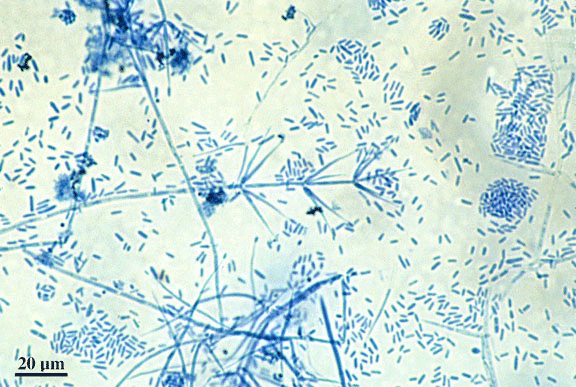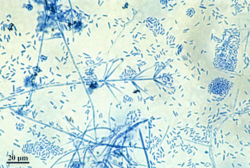Verticillium: Difference between revisions
(Picture Added) |
(Picture Added) |
||
| Line 2: | Line 2: | ||
[[Image:vert1.gif|frame|center|Verticillim. From [http://www.mycology.adelaide.edu.au/gallery/photos/vert1.html]]] | [[Image:vert1.gif|frame|center|Verticillim. From [http://www.mycology.adelaide.edu.au/gallery/photos/vert1.html]]] | ||
[[Image:vert1.gif|thumb|250px|right|Verticillium sp''. by: [http://www.mycology.adelaide.edu.au/gallery/photos/vert1.html]]] | |||
Revision as of 14:28, 22 March 2008
A Microbial Biorealm page on the phylum Verticillium


Classification
Higher order taxa
Division Eucaryota, Kingdom Fungi, Phylum Ascomycota, Class Incertae sedis
Species
Verticillium dahliae
Verticillium lecanii
Verticillium albo-atrum
Description and Significance
Verticillium is a widely distributed filamentous fungus that inhabits decaying vegetation and soil. Some Verticillium species may be pathogenic to arthropods, plants, and other fungi. It is commonly considered as a contaminant. Verticillium may very rarely cause human disease.(1)
Verticillium is a genus of fungi of Ascomycota. This genus has three ecologically based group: mycopathogens, entomopathogens, and plant pathogens and related saprophytes. The commonly known species of Verticillium fall within the plant pathogens group.
Verticillim dehliae and Verticillim albo-atrum cause wilt diseases, which refers to loss of rigidity of non-woody parts of plants, in plants such as cotton, potatos, peppers, eggplants, and tomatoes.
Genome Structure
Cell Structure and Metabolism
Ecology
Pathogenicity and Clinical Significance
Verticillium has been reported as a possible cause of keratitis in humans. (2)(3)
References
(1)http://www.doctorfungus.org/thefungi/verticillium.htm
(2)Larone, D. H. 1995. Medically Important Fungi - A Guide to Identification, 3rd ed. ASM Press, Washington, D.C.
(3)Sutton, D. A., A. W. Fothergill, and M. G. Rinaldi (ed.). 1998. Guide to Clinically Significant Fungi, 1st ed. Williams & Wilkins, Baltimore.
